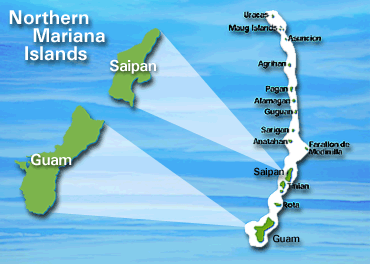Here's the situation: Our government senses a "need", or more precisely, a desire, for 4,000 entities at Location A; meanwhile, at Location B, not far away, there is both a surplus of the same entities, at about the 9,000 level, all under government control, and a congressional mandate that the entities on Location B must leave that territory.
You would think that a rational and thoughtful government would meet its needs at Location A from the surplus at Location B.

But since ours is not always a rational and thoughtful government, it has decided to ignore the surplus at Location B and bring in what it desires from distant lands, all at considerable expense to the nation's taxpayers. And all while needlessly adding to our population.
What I have just described is the congressional decision, sought by the Department of Defense (DoD), to secure 4,000 extra H-2B workers, per year, for DoD-related work in Guam or in the Commonwealth of the Northern Mariana Islands (CNMI), as was reported by my colleague Preston Huennekens. There is a DoD build up on Guam, the nearest U.S. territory to North Korea. If there is a military build-up in the Marianas, it is small in scale. H-2B workers are brought in temporarily to do unskilled work.
There were, needless to say, no hearings on this subject, no votes in committee, no floor votes; it happened in a de facto secret manner; there is a small clause in the omnibus spending bill.
More generally, DoD is operating in the narrowest of silos, thinking only of its short-term staffing desires, and not the long-term interests of the U.S. government; it is never in the interest of our population to bring in more temporary foreign workers than absolutely necessary. More narrowly, there is the irony that Congress has (appropriately) ordered that the huge excess of foreign workers in the CNMI be eliminated by December 31, 2019, a little more than two years from now. Those workers are a sad legacy of the bad old days when CNMI politicians ran their own immigration policy, imported more foreign workers than there were citizen workers in the islands, and proceeded to exploit the former outrageously. During this period, which ended more than 10 years ago, the trade rules were such that garment exports from China to the United States were strictly limited, while Chinese-owned sweatshops in the CNMI could produce goods marked "made in the USA".
After China joined the World Trade Organization it made no economic sense to make clothing in the islands, so the garment factories were closed, but many of their workers stayed in the CNMI. Meanwhile Congress, as of May 8, 2008, included the CNMI under the Immigration and Nationality Act and created a temporary class of foreign workers (with CW visas) to cover the transition from the CNMI's to the federal immigration law.
The legal period for CW workers terminates at the end of 2019 and there are about 9,000 remaining, primarily on Saipan, the largest of these islands.
So why not move some thousands of these workers from Saipan to Guam (a 50-minute hop by plane), seeking legislation, if needed, to do so? Why kick out thousands of workers from one U.S. territory (CNMI) while simultaneously bringing in thousands of additional ones from some distant place?
One bland, and possibly partially correct, answer is that no one thought about it.
Too many officials operate with blinders on. Few think in terms of population and over-population; let's just build those docks and barracks and ignore everything else. It is the silo mentality playing out in the Western Pacific.
Another factor is the employment mind-set of the military on Guam. The island is part of the United States and DoD could bring in construction and other workers from the mainland, but that might add a few dollars an hour to the costs.
The military contractors could also hire local workers, but, to put it ever so gently, the Calvinistic work ethic of the military is not shared by some of the local population, the Chamorros, who are often described as being happier working for GovGuam (the territorial government) than for GovUSA. (I spent some time in these islands while working for the U.S. Department of Interior, about 20 years ago.)
The third of the ignored potential labor forces, the CW workers, are not part of the DoD experience, as H-2Bs are. No agency wants to have to experiment when it does not have to and few agencies want to operate in new ways just because it will meet some social goals laid onto them from above. Further, the CW workers include a large number of women, and one would guess that the largely male contracting organizations in Guam might not like to hire women.
So U.S. citizens, both from the mainland and from the island, women in general, and nonimmigrant workers with existing CW visas, all are to be ignored so brand new, male, and presumably docile, H-2B workers can be imported.
So Congress, with DoD pulling the strings, has given the military what its contractors want, while simultaneously ignoring common sense, the congressional decision on the CW workers, and, as a matter of fact, the general tenor of this White House.
It is the intense, narrow interest of the few, backed in this case by Guam's nearsighted elected officials, that prevails over the broader interests of the rest of us.
It is ever thus.
